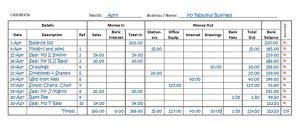
I shouldn’t say all of them, but at least all the regulatory capital ratios and the ones where the Tangible Common Equity go up. And that if you look at it, is really because our Common Stockholders’ Equity is going up by a fair amount, but our funding sources are staying roughly the same. Now for Changes in Other Securities, let’s go and get our Beginning Balance and subtract our Ending Balance. We’re on the Assets side so if this increases we want it to be a negative. And then Changes in Other Assets, go over here and then subtract the ending one. Changes in Deposits, this is considered an operational item for a lot of banks, so we take our Ending Balance and then subtract our Beginning Balance right here.
View Nepal’s Nepal Commercial Banks: Foreign Assets: Foreign Bills & Discounted from Jan 2001 to May 2018 in the chart:
The report includes data on bank earnings, loan and deposit activity, asset quality, and more. When a bank converts some of its Fed reserve balance into currency, it increases currency in circulation and decreases reserves on deposit with the Fed, without changing the overall level of Fed liabilities. Its liabilities are mostly U.S. currency in circulation, bank reserves held in Fed accounts, and reverse repurchase agreements collateralized by Treasury securities.
View Nepal’s Nepal Commercial Banks: Annual: Claim on Government from 1960 to 2017 in the chart:
Banks use much more leverage than other businesses and earn a spread between the interest income they generate on their assets (loans) and their cost of funds (customer deposits). For all bank subsets, seasonally adjusted and not seasonally adjusted data are provided for each balance sheet item published on the H.8 release. The seasonal factors used to adjust the levels are estimated directly for all commercial banks, domestically chartered banks, and large domestically chartered banks. Seasonally adjusted data for small domestically chartered banks and for foreign-related institutions are derived as residuals from those data.
How to Read a Bank’s Balance Sheet
- The higher fourth ratio indicates that the bank is highly leveraged, and there is lower protection against defaults on the loans mentioned above on the asset side.
- The Federal Reserve monitors aggregated balance sheet data to track credit and funding conditions.
- Interest rate risk arises from fluctuations in market interest rates, which can affect a bank’s earnings and economic value.
- The instructions also show the relationship of FR 2644 items to items on the quarterly Call Reports.
- The signaling function of quantitative easing has at times ensured that benchmark bond yields rose while the Fed was buying only to drop once the purchase program was discontinued.
So I’m just going to take them, press Shift and then Ctrl+R to copy all these over, and so we have that. Now in our simplified example, we’re not quite going to do it that way. Instead what I’m going to do is just keep all of these items constant for now. So starting from the top, Available for Sale Securities will be kept constant, Other Securities will be kept constant. These would normally be projected as a percent of loans or as a percent of deposits, but we don’t have our loans or deposits yet, so we’re just going to do that.

Balance Sheet: Unused Loan Commitments – Total: All Other Unused Loan Commitments
Deposits are like debt in that it is money that the banks owe to the customer but they differ from debt in that the addition or withdrawal of money is at the discretion of the depositor rather than dictated by contract. Assets earn revenue for the bank and includes cash, securities, loans, and property and equipment that allows it to operate. Liabilities represent the bank’s obligations to creditors, depositors, and others. These are divided into customer deposits and borrowings that fund a bank’s operations. On the other hand, mortgage loans are issued to individuals to enable them to purchase a house.
Interest revenue captures the interest payments the bank receives on the loans it issues. Other times, this line will consolidate gross interest revenue and deduct interest expense to find net interest revenue. This interest expense is the direct interest expense paid to the deposits used to fund the loans, and does not include interest expense from general debt. The main operations and source of revenue for banks are their loan and deposit operations. Customers deposit money at the bank for which they receive a relatively small amount of interest. The bank then lends funds out at a much higher rate, profiting from the difference in interest rates.
These effects on the assets of domestically chartered commercial banks due to the definitional balance sheet of a commercial bank clarifications were estimated from data reported weekly by FR 2644 sample banks. For more information on the construction of the H.8 data, please see the About page. Borrowing from other sources to meet up with loan demands does not work out well for a bank and may eventually lead to its crash. This type of liability enables banks to earn more money from the interest that borrowers will pay. There is also a section in the bank’s balance sheet that creates allowances to cover losses. The amount set aside for this is dependent on the prevalent economic condition per time.

Revised data extending back to January 2018 will be released with a future benchmark. Effective with the release dated April 11, 2025 (with data as of April 2, 2025), a change will be made to the data collection supporting the H.8 release. The Pauper’s Money Book shows how you can manage your money to greatly increase your standard of living.

H.8 Assets and Liabilities of Commercial Banks in the United States
Post-2009 crisis, the government took specific initiatives to restore faith in the banking system. The Financial Accounting Standards Board has allowed Banks to Oil And Gas Accounting value their assets at a Fair Value. Banks are now also allowed to record income on the income statement if the market value of the debt decreases. This change is because the bank could buy its debt in the market and reduce the debt amount.
View Nepal’s Nepal Commercial Banks: Claim on Government from Jan 2001 to May 2018 in the chart:
To start with on the Assets sides, projecting loans, deposits, and key interest earning assets & interest bearing liabilities. https://taradmc.com/bookkeeping-9/understanding-deposit-slips-key-components-and/ So in real life, the key point here is to figure out how much the loans you’re increasing by, we just set this to a $100 or a $100 million increase in this period. In reality, we would probably tie this to the GDP growth rate and the bank’s market share, but that’s what we’ve set up for now. And then based on that, and a new deposit number which we’d also probably tie to the loans in some way, we could project everything else on here.